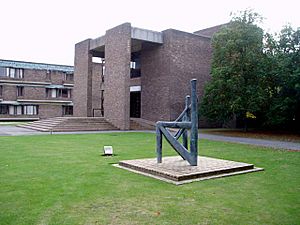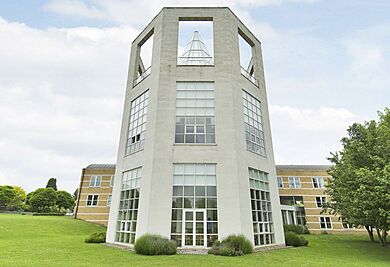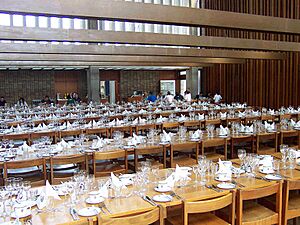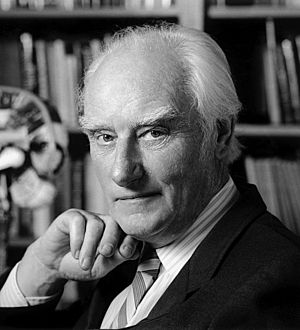Churchill College, Cambridge facts for kids
Quick facts for kids Churchill College |
||||||||||||||||
|---|---|---|---|---|---|---|---|---|---|---|---|---|---|---|---|---|
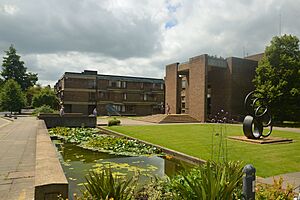
Entrance to Churchill College in June 2019
|
||||||||||||||||
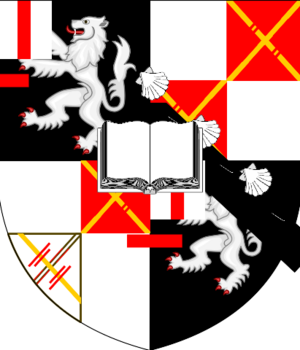
Arms of Churchill College
|
||||||||||||||||
|
|
||||||||||||||||
| University | University of Cambridge | |||||||||||||||
| Location | Storey's Way, Cambridge CB3 0DS (map) | |||||||||||||||
| Coordinates | 52°12′47″N 0°06′04″E / 52.213°N 0.101°E | |||||||||||||||
| Abbreviation | CHU | |||||||||||||||
| Motto in English | Forward | |||||||||||||||
| Established | 1958 | |||||||||||||||
| Named after | Winston Churchill | |||||||||||||||
| Sister college | Trinity College, Oxford | |||||||||||||||
| Master | Sharon Peacock | |||||||||||||||
| Undergraduates | 504 (2022-23) | |||||||||||||||
| Postgraduates | 348 (2022-23) | |||||||||||||||
| Map | ||||||||||||||||
Image:Cmglee Cambridge Churchill College archives centre hall.jpg
Churchill College is a part of the University of Cambridge in England. It's known for focusing on science, engineering, and technology. However, it also cares about arts and humanities.
The college was started in 1958 by a group led by Sir Winston Churchill. They wanted to create a college for 60 teachers (called fellows) and 540 students. It was meant to be a national tribute to Winston Churchill. Queen Elizabeth II officially approved its rules in August 1960.
Churchill College is located outside the main city center of Cambridge. It is close to the university's newer development area. The college has 16 hectares (about 40 acres) of land. This makes it the largest college in Cambridge.
Churchill was the first college that used to be only for boys to decide to accept girls. It was one of three colleges that welcomed its first female students in 1972. Within 15 years, all other colleges followed this change. The college is known for being more relaxed than some other Cambridge colleges. It also traditionally accepts more students from public schools.
The college's motto is "Forward." This comes from the last part of Winston Churchill's first speech as Prime Minister of the United Kingdom. In his famous "blood, toil, tears and sweat" speech, Churchill said, "Come, then, let us go forward together."
Contents
College History
How Churchill College Started
In 1955, after he stopped being prime minister, Winston Churchill talked with friends about starting a new school. He was impressed by the Massachusetts Institute of Technology in the United States. He wanted a similar science and technology school in Britain.
These plans changed into creating a science-focused college within the University of Cambridge. Churchill also wanted students who studied arts and humanities. This was to make sure everyone got a well-rounded education. Because of this, the college accepts students for almost all subjects.
Early Years and Student Rights
The first postgraduate students arrived at Churchill College in October 1960. The first undergraduate students came a year later. The college became a full part of the university in 1966.
In 1970, the college's student union, called the Junior Common Room (JCR), helped students gain the right to vote in their university towns. This happened after the voting age was lowered to 18 in 1969.
At first, only male students were allowed. But in 1972, Churchill College was one of the first three colleges to accept female undergraduate students.
Focus on Science and Postgraduates
Even today, Churchill College focuses on science and engineering. About 70% of its students each year study these subjects. The college rules also say that one-third of the students should be studying for a postgraduate degree.
Cambridge University Radio (later called Cam FM) used to broadcast from Churchill College. It was there from 1979 until 2011.
Buildings and College Grounds
Designing the College
In 1958, the college bought a large piece of land, about 170,000 square meters (42 acres). This land used to be farmland. After a design competition, Richard Herbert Sheppard was chosen to design the new college.
The main buildings were finished by 1968. They include nine living areas for students, separate flats for graduate students, and a central building. This central building has the dining hall, a buttery (a place to eat and drink), common rooms, and offices.
Dining Hall and Archives
The dining hall at Churchill College is the largest in Cambridge. It is 22 meters (about 72 feet) square and very tall. It can serve meals for up to 430 people at once.
The main college buildings are built around a large central area where the library is located. In 1974, an addition was built onto the library. This new part became the Churchill Archives Centre. It was first made to keep Sir Winston Churchill's important papers.
Since then, it has also received papers from other important people. These include former Prime Ministers Margaret Thatcher and John Major. It also holds papers from famous scientists and engineers like Rosalind Franklin and Sir Frank Whittle.
Other Buildings
In 1992, the Møller Centre for Continuing Education was built on the Churchill site. It was designed by Henning Larsen. This center is for training and conferences, bringing together education and business.
Richard Sheppard also designed separate flats for married graduate students. These are called the Sheppard flats. They are a short walk from the main college buildings. The college's central buildings and chapel were officially recognized as important historical buildings in 1993.
The College Chapel
The chapel is located at the far end of the college grounds. The first design for the college had the chapel closer to the main entrance. However, some of the first teachers (fellows) were not happy about having a religious building in a modern, science-focused school. One famous scientist, Francis Crick, even resigned because of it.
Eventually, they found a solution. The chapel was built a bit further away and was managed separately from the rest of the college. It is often called "the Chapel at Churchill College." The chimney at the front of the college looks like a chapel tower, even though the actual chapel is elsewhere.
Artworks and Sculptures
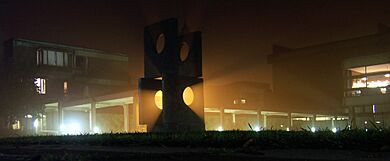

Churchill College has many examples of modern art. These include:
- Four-Square (Walk Through) (1966) by Dame Barbara Hepworth
- Prints of Marilyn Monroe by Andy Warhol
- Gemini (1973) by Denis Mitchell
- Diagram of an Object (Second state) (1990) by Dhruva Mistry
- Spiral by Michael Gillespie (1993)
- Flight by Peter Lanyon (1981)
- Black Bag by Graham Murdoch (1990)
- Past, Present, Future by Geoffrey Clarke (2010)
There are also artworks by Sir Eduardo Paolozzi, Bridget Riley, Patrick Caulfield, Sir Peter Blake, and Daphne Hardy Henrion.
Hepworth's Four-Square (Walk Through) is located at the west exit of the main college buildings. Another sculpture, Diagram of an Object (Second state) by Mistry, is now next to the chapel. Beast Alerted 1 by Lynn Chadwick stands near the front gate of the college.
Student Life
Student Groups
The students at Churchill College are part of two main groups. Undergraduates are in the Junior Common Room (JCR). Postgraduate students are in the Middle Common Room (MCR). Students studying for a Master's degree can choose which group to join.
These student groups organize many academic and social events. They also help students with their well-being. The college helps fund sports clubs and other groups that provide fun activities for students.
Social Events and Fun
Every two weeks during the autumn and spring terms, Churchill hosts "Pav." This is a music event that is free and open to all university members. It used to be held in the college's pavilion buildings, which is where its name comes from. Since 1992, Pav has been held in the Buttery, which is the main bar area.
In the past, the college held a big dance called a May Ball. Now, Churchill holds a Spring Ball every February, around Valentine's Day. This ball has featured popular bands like The Wombats and The Noisettes.
During May Week, the JCR organizes a free garden party. This event features performances by local bands and musicians.
Students also run Churchill Casino. This group provides professional casino games for events like Cambridge May Balls. The money they earn is given back to the college and to local charities.
The MCR has its own special area called the Sandy Ashmore Room. Here, postgraduate students can relax and socialize. It has a student-run bar called the Vicious Penguin. The MCR organizes many activities, including an annual conference called the Conference on Everything. This conference lets students share their research. It also features talks from important speakers.
Sports at Churchill
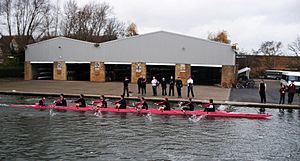
Churchill College has its own sports fields on site, which is different from many other colleges. This makes sports a big part of college life. Besides football and cricket pitches, there's a gym, tennis courts, and squash courts.
The Churchill College Football Club (CCFC) was the first college team to win the Cambridge University Amateur Football League Division 1 title two years in a row (2005–06 and 2006–07). They also reached the final of the Cuppers competition in 2006–2007.
The college also has a successful boat club, the Churchill College Boat Club. In 2013, they won the Pegasus Cup, which is given to the best college boat club in the May Bumping Races. In 2015, they made history by winning both the Pegasus Cup and the Marconi Cup (for the Lent Bumps) in the same year.
College Traditions
Churchill is a newer college and is proud to be modern. It has fewer traditions than older colleges. Informal hall, which is like cafeteria-style dining, started in 1971. This was an alternative to formal hall, where meals are served at a set time and everyone wears academic gowns. At Churchill, students don't have to wear gowns at formal halls, except for special college feasts.
During special formal meals, like the Matriculation Dinner, the Master (head of the college) usually makes a toast. First, they toast "The King" and then "Sir Winston." In other formal halls, a senior student usually makes the toast after the teachers (fellows) have left. This tradition started in the early 2000s. Students would toast in the opposite order: "Sir Winston," followed by "The Queen."
People at Churchill College
College Masters
The Master of Churchill College is chosen by the King. The college has had eight Masters so far:
| Name | Term of office | Notes |
|---|---|---|
| Sir John Cockcroft | 1959–1967 | Nobel Prize winner in Physics, known for splitting the atom. |
| Sir William Hawthorne | 1968–1983 | An engineer who helped create the jet engine. |
| Sir Hermann Bondi | 1983–1990 | A scientist who studied the universe and helped develop the Steady State theory. |
| Lord Broers | 1990–1996 | A nanotechnologist; later became the Vice-Chancellor of the University of Cambridge. |
| Sir John Boyd | 1996–2006 | Was the British ambassador to Japan before this role. |
| Sir David Wallace | 2006–2014 | Was the Vice-Chancellor of Loughborough University before this. |
| Dame Athene Donald | 2014–2024 | A professor of experimental physics. |
| Sharon Peacock | 2024– | A professor of Public Health and Microbiology at the University of Cambridge. |
Professor Sharon Peacock became the 8th Master in October 2024.
Nobel Prize Winners
Many people connected to Churchill College have won the Nobel Prize. Here are some of them:
- Philip Warren Anderson – Physics, 1977
- John Cockcroft – Physics, 1951
- Francis Crick – Physiology or Medicine, 1962 (co-discoverer of DNA structure)
- Angus Deaton – Economics, 2015
- Gérard Debreu – Economics, 1983
- Peter Diamond – Economics, 2010
- Robert G. Edwards – Physiology or Medicine, 2010
- John Gurdon – Physiology or Medicine, 2012
- Antony Hewish – Physics, 1974 (co-discoverer of pulsars)
- William Lipscomb – Chemistry, 1976
- Mario Vargas Llosa – Literature, 2010
- Eric Maskin – Economics, 2007
- Paul Nurse – Physiology or Medicine, 2001
- Wole Soyinka – Literature, 1986
- David Thouless – Physics, 2016
- Roger Tsien – Chemistry, 2008
Famous Alumni
Many notable people have studied at Churchill College. Here are a few:
- Baroness Brinton – A member of the Liberal Democrat party in the UK Parliament.
- Michael Burrows – Invented Alta Vista, one of the first internet search engines.
- Peter Fincham – Former head of BBC One, a major TV channel.
- Catherine Green – A biologist who worked on the Oxford–AstraZeneca COVID-19 vaccine.
- Michael Green – A very important professor of Mathematics at Cambridge.
- Diarmaid MacCulloch – A famous historian.
- Andrew Parker – Former head of MI5, the UK's security service.
- Bjarne Stroustrup – The person who invented the computer programming language C++.
- Ian Stewart – A well-known mathematician.
- Rick Warden – An actor known for TV shows like Band of Brothers.
See also
 In Spanish: Churchill College para niños
In Spanish: Churchill College para niños
- Churchill Scholarships for students from the United States
- Churchill College Boat Club
- Listed buildings in Cambridge (west)



